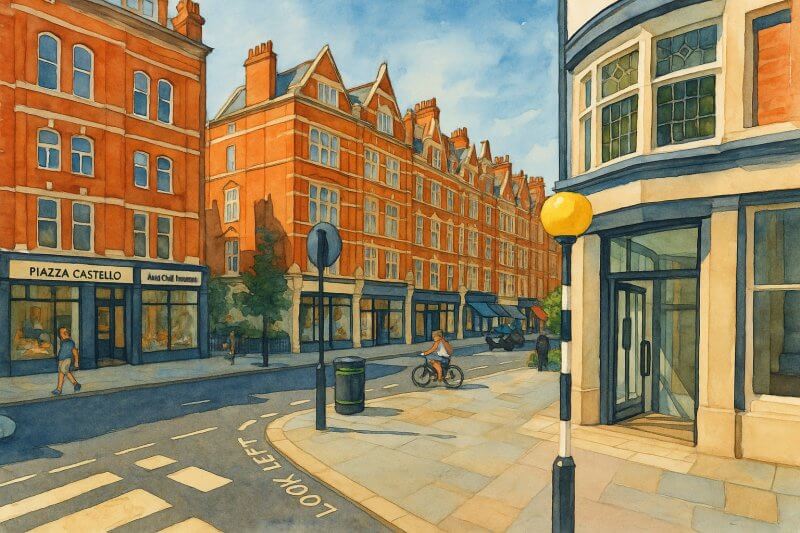
Marylebone, London
Marylebone, London: A Charming Village in the Heart of the City
Where Sophistication Meets Community Spirit
Marylebone is one of London’s most delightful neighborhoods — a blend of refined elegance, charming streets, and a lively, village-like atmosphere.Perfectly situated between the bustle of Oxford Street and the grandeur of Regent’s Park, it offers the best of London living with a uniquely intimate character.
Where Is Marylebone Located?
Marylebone sits within the City of Westminster in Central London.If you look at the map created for this webpage, you’ll see Marylebone divided into two main sections:
- North Marylebone: This area extends up toward Regent’s Park, with a slightly more residential character, leafy streets, and proximity to Baker Street and the medical institutions along Harley Street.
- South Marylebone: Closer to Oxford Street, this section is more commercial, featuring elegant shops, boutiques, and iconic streets like Marylebone High Street and Wigmore Street.
- North: Regent’s Park
- South: Oxford Street
- West: Edgware Road
- East: Great Portland Street
Size and Population of Marylebone
Marylebone covers an area of about 1.2 square miles (3.1 square kilometers). As of recent estimates, the residential population of Marylebone is approximately 22,500 people, although daytime numbers swell much higher due to commuters, shoppers, and tourists.Map of Marylebone, London
Streets in Marylebone
- Baker Street
- Duke Street
- Gloucester Place
- Harley Street
- Marylebone Road
- Portland Place
- Wigmore Street
History of Marylebone
Marylebone has a long and fascinating history. The name "Marylebone" comes from St Mary by the Bourne — a medieval church that once stood by a small stream (bourne). Over time, the name evolved into "Marylebone." The pronunciation can be a little surprising:- Common Spelling: MAR-le-bun or MAR-li-bun
- International Phonetic Alphabet (IPA): /ˈmɑːrlɪbən/

Demographics of Marylebone
Marylebone's population is diverse and cosmopolitan, reflecting London's broader trends.- Ethnicity: A blend of White British, other White backgrounds (particularly European and American residents), Asian communities, and others.
- Age: A healthy mix of young professionals, families, and older residents.
- Economics: Generally affluent, with some pockets of more mixed-income housing.
Real Estate Prices in Marylebone
Marylebone is among the pricier areas of London but offers a slightly better value compared to Mayfair or Knightsbridge.As of early 2025:
- Average property price in Marylebone: around £1.7 million
- Average flat price: approximately £1.2 million
- Comparison to London average: London’s average property price stands at about £550,000
Important Buildings and Landmarks in Marylebone
Marylebone is home to some iconic sights and institutions:- Madame Tussauds London: The world-famous wax museum.
- The Sherlock Holmes Museum: Dedicated to the famous fictional detective at 221B Baker Street.
- Wallace Collection: A magnificent art collection in a historic townhouse.
- Wigmore Hall: An internationally renowned classical music venue.
- Royal Academy of Music: A leading conservatoire for musicians.
- Marylebone High Street: A shopping street lined with independent boutiques, cafes, and restaurants.
- Daunt Books: A famous Edwardian bookshop specializing in travel books.
Characteristics of Marylebone
Marylebone combines the best aspects of urban and village life.Its key characteristics include:
- Charming Architecture: Georgian townhouses, elegant mansion blocks, and picturesque mews.
- Community Feel: Despite its central location, Marylebone maintains a close-knit, village-like atmosphere.
- Fashionable Yet Relaxed: It's stylish but never overwhelming, with a quieter feel compared to the neighboring West End.
- Green Spaces: Proximity to Regent’s Park and smaller gardens scattered throughout the area.
Nearest London Underground Stations
Marylebone is extremely well-connected by public transport.Nearby Underground stations include:
- Baker Street Station: Served by the Bakerloo, Jubilee, Metropolitan, Circle, and Hammersmith & City lines.
- Regent's Park Station: Served by the Bakerloo line.
- Marylebone Station: Served by the Bakerloo line and National Rail services.
- Bond Street Station: Served by the Central, Jubilee, and Elizabeth lines.
- Oxford Circus Station: Served by the Bakerloo, Victoria, and Central lines.
Fun Facts About Marylebone
Here are a few tidbits that might surprise you:- Madonna Effect: When Madonna lived in Marylebone in the early 2000s, local real estate prices reportedly rose due to the "celebrity effect."
- Sherlock Holmes Festival: Every January, a small parade and events celebrate Sherlock Holmes’s birthday near Baker Street.
- The Old Tyburn Tree: Marylebone was once near the infamous Tyburn gallows where public executions were held until the late 18th century.
- Marylebone Cricket Club (MCC): Although based at Lord's in nearby St John's Wood, the MCC was originally founded in Marylebone and is still associated with its name.

Painting of Marylebone (View full-size image here)